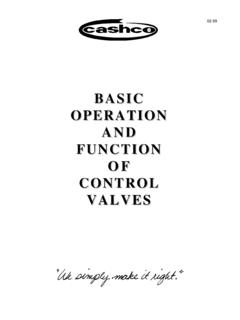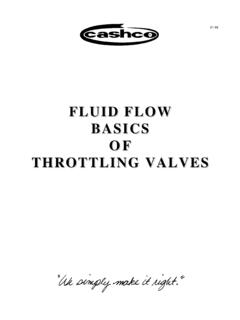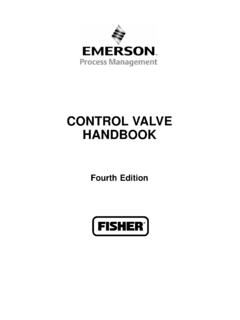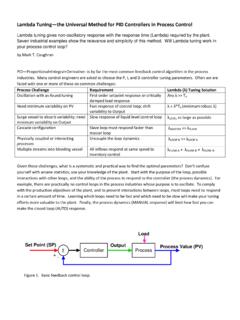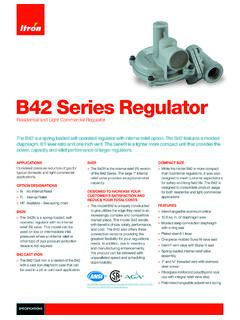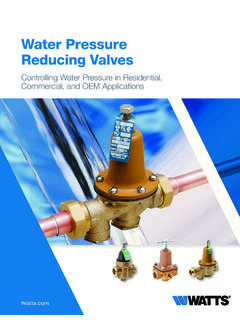Transcription of REGULATOR – PRINCIPLE OF OPERATION
1 -1- REGULATOR PRINCIPLE OF OPERATIONREGULATOR PRINCIPLE OF OPERATIONI. PRESSURE REDUCING REGULATORSA. OPERATION1. Point Force Versus Distributed Force2. Force Balance Principle3. Flow To Open Versus Flow To Close Design4. Dome loaded and DifferentialB. PROPORTIONAL BAND (DROOP, PRESSURE BUILD)1. Cause and Effect2. How Can Proportional Band Work For You?3. How to Lessen the EffectII. BACK PRESSURE REGULATORSA. OPERATION1. Point Force Versus Distributed Force2. Force Balance Principle3. Dome loaded and DifferentialB. PROPORTIONAL BAND (DROOP, PRESSURE BUILD)1. Cause and How to Lessen the DEFINITIONSREGULATOR DEFINITIONSBACK PRESSURE REGULATOR : REGULATOR that is designed to relieve pressure above setpoint. Inletpressure is the control or set WORKING PRESSURE: The maximum pressure at which a REGULATOR or fitting is allowed to beused at ambient END: When the flow is terminated down stream of the REGULATOR requiring tight shut off of REGULATOR : REGULATOR terminology normally used to describe inches water column check set pressure before SEAT: A flow control orifice and seat that is an integral part of the body or cage material ormay be constructed from material added to the body or cage; non- : Mating contact surfaces that have been refined by grinding and/or polishing together orseparately in appropriate : The flow curve between seat shut off and that point when seat lifts OPERATED REGULATOR : REGULATOR designed to maintain constant control pressure over a widerange of flowing conditions.
2 Utilizes the system medium via pilot valve to operate main BUILD: When control pressure or set pressure rises above set DROOP: When control pressure or set pressure falls below set REDUCING REGULATOR : A REGULATOR that is designed to reduce pressure. The outletpressure is the controlled BAND: Deviation in controlled pressure as flow rate : The ratio of the largest flow coefficient (max Cv) to the smallest flow coefficient(min Cv); Rg =Max Cv .Min CvREPEATABILITY: The closeness of agreement among a number of consecutive measurements of theoutput for the same REGULATOR of input under the same operating conditions, approaching from the samedirection, for full range traverse. It does not include RELIEF VALVES: Coded ; used to protect code designed pressure vessels and pipe systemsagainst over REGULATOR : A REGULATOR which is activated by the fluid flowing through the : The ratio of change in output magnitude to the change of the input which causes it aftersteady state has been : The controlled pressure at a low flow rate (approximately 2% of Max Cv); flow slightly be-yond lockup : Functional parts of a REGULATOR which are exposed to the line fluid.
3 Usually refers to the stem,closure member and seating someone just wants to control his pressure, any of the above three types of valves will do thejob. However, when determining what the application requires (or doesn't need), the followingguide should help determine which valve design would best match the application :CRV=Control ValvePOR=Pilot Operated RegulatorREG=Self-contained RegulatorFTC REG= REGULATOR , Flow-to-CloseFTO REG= REGULATOR , Flow-to-OpenCRV WP=Control Valve with PositionerCRV WOP=Control Valve without PositionerFACTOR CONSIDEREDBESTNEXTLASTLine Size Cost Thru 1-1/2"REGPORCRV 2" thru 3"PORREGCRV 4" and UpCRVPORREGCost/Cv Thru 1-1/2"PORREGCRV 2" and UpCRVPORREGC apacityCRVPORREGO utlet Pressure Level CapabilityCRVREGPORO utput Pressure Level MaintenanceCRVPORREGof SetpointRangeabilityFTO REGCRV/PORFTC REGR equirements for External Power REG/PORCRV(Air or Electricity)StabilityCRVREGPORS peed of ResponseREGPORCRV WOP/CRV WPAbility to Adapt to System DynamicsCRVPORREGFail-Safe ActionCRV POR/REGA daptability (Add accessories,CRVREGPORM odify Action)
4 Remote Set Point CapabilityCRVR egulator,POR/REGDome LoadedMaintenance Cost/Spare PartsREGPORCRVHOW TO DIFFERENTIATE BETWEENHOW TO DIFFERENTIATE BETWEENAPPLYING A REGULATOR vs. PILOT-OPERATEDAPPLYING A REGULATOR vs. PILOT-OPERATEDvs. PNEUMATIC CONTROL VALVEvs. PNEUMATIC CONTROL REDUCING REGULATOR A proportional only control device that controls and responds tochanges in its OUTLET pressure due to flow regulators are sometimes known as tracking or bias regulatorsP1 - P3 Pconstant Pconstant = Prange springsettingPressure Reducing PRESSURE REGULATOR A proportional only control device that controls and responds tochanges in its INLET - P3 Pconstant Pconstant = Prange springsettingGlobe DesignFlow-Thru Angle PRESSURE REGULATOR A proportional only control device that maintains a CON-STANT DIFFERENTIAL PRESSURE between a reference pressure and the pressure of the controlled Pressure Reducing RegulatorDifferential Back PILOTED REGULATOR A proportional + reset control device that uses a piston or dia-phragm actuated main valve controlled
5 By a separate external pilot REGULATOR that uses the flowing fluid as itspower Piloted Reducing RegulatorExternal Piloted Back Pressure Reducing loaded REGULATOR A REGULATOR using a fixed volume and pressure of compressible fluidas a spring and set point reference to accomplish pressure reduction or back pressure regulation. Some-times called a Dome loaded loaded Reducing CONTROLLABLE FLOW The lowest flow at which a steady regulated condition of the con-trolled variable can be The value of regulated pressure at the MINIMUM controllable The pressure deviation from setpoint pressure when the REGULATOR is fully COEFFICIENT (Cv) The REGULATOR capacity in GPM of H2O at 20 C at one psi pressure drop at fullrated travel. Refer to ISA and for Testing Procedures and Sizing GRAVITY The ratio of the weight of a given volume of a fluid to the weight of an equal volume ofwater (liquids) or air (gases) at standard HIGH INLET PRESSURE INT ERMEDIAT E PRESSURE LOW OUTLET PRESSUREPPP1122P SENSING& UNLOADING2P SENSING& UNLOADING2 PILOT VALVEP SUPPLY1P LOADING12 PISTONMAIN VALVEOUTLETP2 INLETP1P2 P3(P3 slightly higher)= HIGH INLET PRESSURE= HIGH-INTERMEDIATE PRESSURE= LOW-INTERMEDIATE PRESSURE= LOW OUTLET PRESSUREPPPP112222 UNLOADINGP ILO T VA LVELOADINGP12 SMALL RESTRICTIO N ORIFICE LA RGE RESTRICTIO N ORIFICEUNLOADINGDIAPHRAGM MAIN VALVEP SUPPLY & SENSING1O UTLE (GAUGE) Pressure above atmospheric (ABSOLUTE) The sum of atmospheric and gauge (OPERATING)
6 The actual pressure at which a device operates under normal conditions. Thispressure may be positive or negative with respect to atmospheric POINT In a valve which is opened by an increase in inlet pressure (from an open condition) theleakage just stops as evidenced by the cessation of bubbles passing the sealing element when submerged ALLOWABLE OPERATING PRESSURE The maximum pressure that the valve may beoperated at, as determined by the manufacturer, taking into account function and a factor of safety based onmaterials of SEAL an elastomeric, plastic, or other readily formable material used either in the valve plug or seatring to provide tight shut-off with minimal force see for leakage FACING A material harder than the surface to which it is applied; usually applied to valve seats toresist galling or fluid SEATED A valve having a plug with a single SEATED A valve featuring a plug with two A valve featuring a pressure balanced plug with two A valve where the plug is partially pressure A valve where the plug closure number is not pressure balanced; generally single LEAKAGE CLASSIFICATION A leakage classification based on ANSI I.
7 A modification of any Class II, III, or IV valve where design intent is the same as the basic class,by agreement between user and supplier, no test is II. This class establishes the maximum permissible leakage generally associated with commercialdouble-port, double-seat control valves or balanced single-port control valves with a piston ring seat andmetal-to-metal seats. Use test procedure Type III. This class establishes the maximum permissible leakage generally associated with Class II, butwith a higher degree of seal tightness. Use test procedure Type IV. This class establishes the maximum permissible leakage generally associated with commercialunbalanced, single-port, single seat control valves and balanced single-port valves with extra tight pistonrings or other sealing means and metal-to-metal seats. Use test procedure Type V.
8 This class is usually specified for critical applications where the control valve may be required tobe closed, without a blocking valve, for long periods of time with high differential pressure across the seatingsurfaces. It requires special manufacturing assembly testing techniques. This class is generally associatedwith metal seat, unbalanced single-port, single seat control valves or balanced single port designs withexceptional seat and seal tightness. Use test procedure Type B using water at the maximum operatingdifferential VI. This class establishes the maximum seat leakage generally associated with resilient seatingcontrol valves either unbalanced or balanced single port with O rings or similar gapless seals. Use testprocedure Type = Higher Inlet PressureP2 = Lower Out let PressureFrsF = Force of Range SpringF = Force of Pist on SpringPressure Plate Fup FdownFpsPLUGD portDiaphragmWorks by the FORCE - BALANCE PRINCIPLErsF + (P1 x A ) + (P2 x A ) =psportdiaph Fup Fdown=F+ (P2 x A )portrspsOUTLETP2P1 INLETPLUG MOVES DOWNRANGE SPRING RELAXESTO INCREASE FLOW++DIAPHRAGM MOVES DOWNP2 PRESSURE DECREASESFTC REDUCING REGULATORSFTC REDUCING regulators -8-_FFFFFTTTTTCCCCC FFFFFLLLLLOOOOOWWWWW TTTTTOOOOO CCCCCLLLLLOOOOOSSSSSEEEEE _FT C_FFFFFTTTTTOOOOO FFFFFLLLLLOOOOOWWWWW TTTTTOOOOO OOOOOPPPPPEEEEENNNNN _FT OFTO vs.
9 FTCFTO vs. FTC Unstable asplug nears theseat; lowflow. Lowerrangeability. Stable as plugnears or departsthe seat; allflows. Very REDUCING REGULATORFTO REDUCING REGULATORFTO INCHES WATER COLUMN REGULATORFTO INCHES WATER COLUMN REGULATORL arge DiaphragmForce MultiplicationLeverFTO; stable @ seat. Soft Pressure Reducing REGULATOR - WC P1 = Higher Inlet PressureP2 = Lower Out let PressurePressure Plate Fup FdownInlet Pressure Tends To "Push" The Plug INCREASEFLOWPLUG MOVES RIGHT+DIAPHRAGM MOVES DOWNRANGE SPRING RELAXES+P2 OUTLET DECREAS ESRo ckerArmDiaphragmPLUGO UTLE TP2P1 INLET-10-_FTO REDUCING REGULATORP1 = Higher Inlet PressureP2 = Lower Out let Pressure Fup FdownP2 OUTLETP1 PLUGI nlet Pressure Tends To "Push" The Plug Open. TO INCREASEFLOWPLUG MOVES DOWN+DIAPHRAGM MOVES DOWNRANGE SPRING RELAXES+P2 OUTLET DECREAS ESCAGESEATPISTONPRESSURE PLATEP2P2_with BALANCED TRIMP1P1 INLET-11-DIAPHRAGMS DIAPHRAGMS How BIG are the FORCES ?
10 How BIG are the FORCES ?PROPORTIONAL BAND -PROPORTIONAL BAND -REDUCING REGULATORREDUCING REGULATORP= 100 #/in2 DiaphDiaph=Diaph= 6 4=x D2 ADiaphPxDiaphADiaphF= 2830 #Diaph=Diaph= 12 4=x D2 ADiaphPxDiaphADiaphF= 11,300 #12 ETPOINTLESS THAN 10%_OUTLET PRESSURELOCKUP ZONEFULL OPENMECHANICAL LIMITPRESSURE DROOP PRESSURE FALLOFF PROPORTIONAL BAND10%20%30%40%00_FLOW CAPACITYHILOW-12-P1 = Higher Inlet PressureP2 = Lower Outlet PressureP3 = Loading PressureP3 Pressure Plate Fdown FupFpsPLUGD iaphragmWorks by the FORCE - BALANCE PRINCIPLE Fup Fdown=F + (P1 x A ) + (P2 x A ) =psportdiaph(P2 x A ) + (P3 x A )portdiaphOUTLETP2 INLETP1 PRESSURE loaded REDUCING REGULATORPRESSURE loaded REDUCING REGULATORP2 P3-13-FTO PRESSURE loaded REDUCING REGULATOR with BALANCED TRIMP1 = Higher Inlet PressureP2 = Lower Out let PressurePL = Loading Pressure Fup FdownP2 OUTLETP1 PLUGI nlet Pressure Tends To "Push" The Plug Open.
